The Dawes Transporteur: a Lovely Frankenbike for Everyone and No One
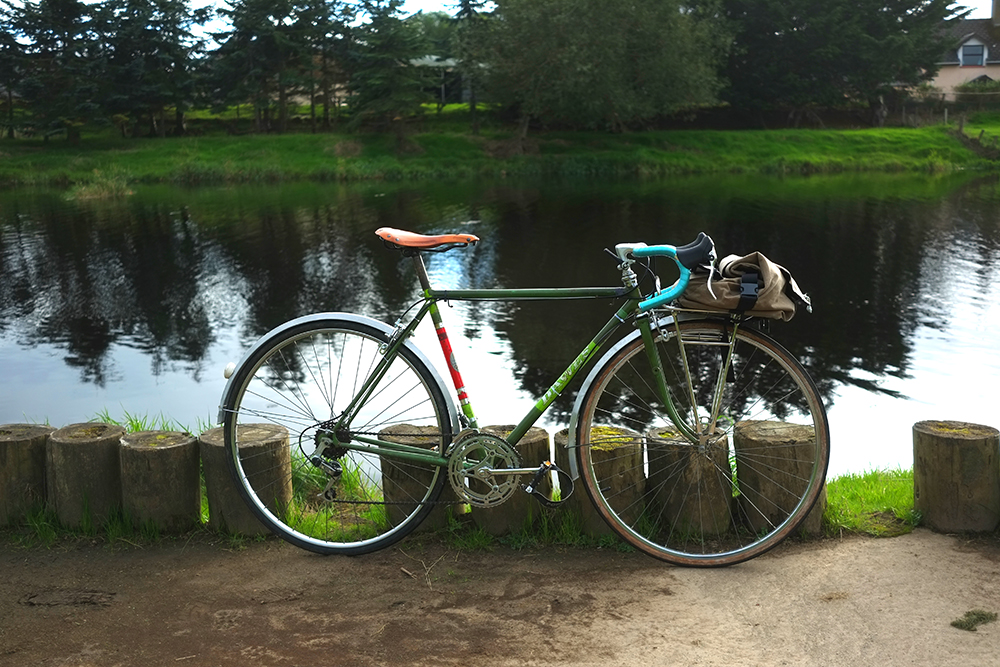
Some time ago I wrote about a mystery Dawes frameset that was bought by a friend under the impression it was a tiny 53cm frame that could be built up as a winter racer. On receipt, the frame turned out to be of the "long and low" variety - its 50cm seat tube and virtually non-existent head tube completed by a whopping 56cm of top tubage. The purchase price not being worth the return postage, the frameset was kept - and submitted to me on a "see what can be done with this!" basis.
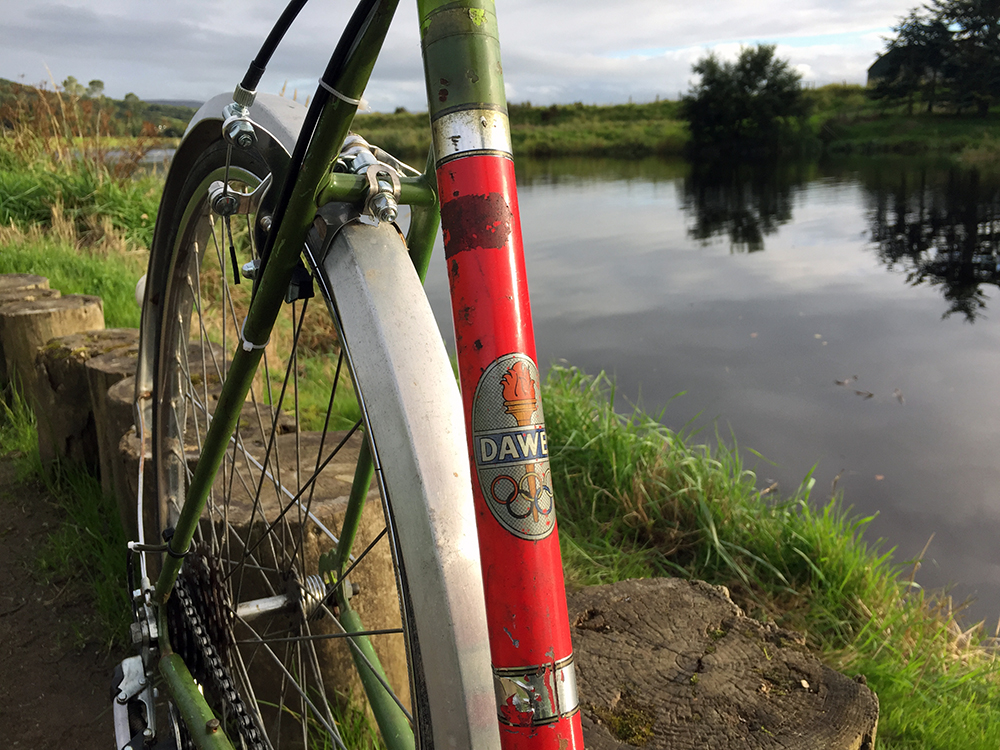
I looked at the frameset this way and that, but truth be told was not particularly inspired. I knew the only way it would fit me personally, was if I were to put swept-back handlebars on it. But I just wasn't feeling an upright setup for this frame. So I consulted with my friend Bryan, who is a bit of an expert on building up fabulous beater bikes. He suggested a drop bar transpor-touring type setup with a 3-speed Sturmey Archer hub and low gearing. Now that sounded like the right direction! However, when we pooled our available spare parts for the build, we did not have the right brakes for that setup. Or a second 700C wheel to go with the Sturmey Archer one, for that matter. So we scrapped the idea of trying to make this bike into something interesting, and instead decided to throw whatever parts on it we had between us just to see how it rode.
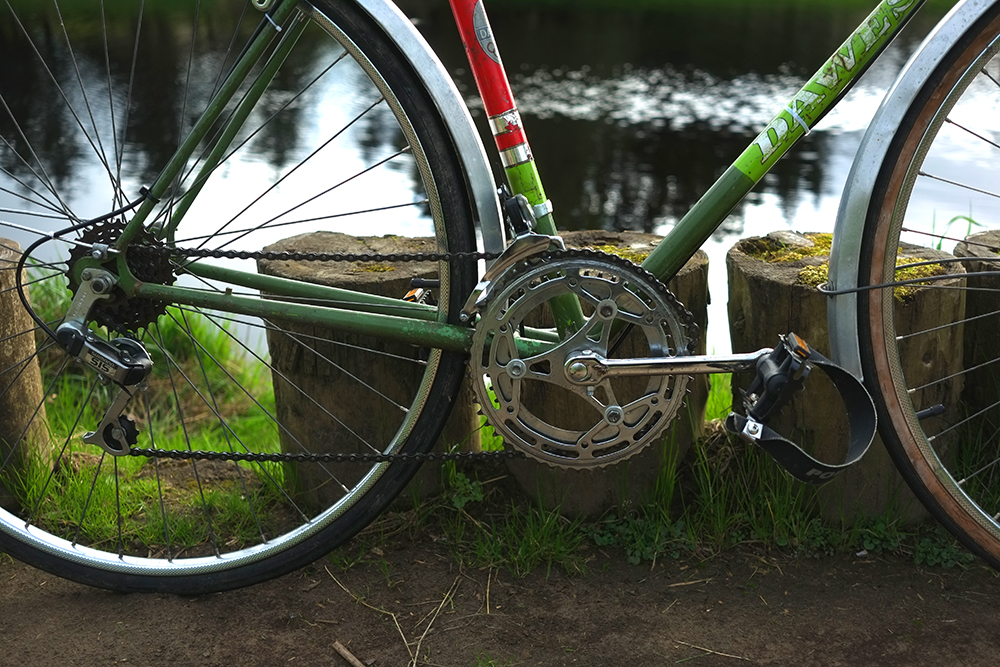
The pot luck of spare parts included an old steel 27" wheelset with crumbling 32mm gumwall tyres, a cottered crankset, a random early '80s 10-speed drivetrain with a pair of stem shifters, a set of long-reach calipers, a straight seatpost and a shorty stem - all pulled off of discarded bikes. Clashing wildly with this mashup was my more contemporary contribution of a Selle Anatomica saddle, Nitto Noodle handlebars and Tektro short-reach brake levers. We used a roll of old NOS shimmery teal bar tap as a temporary measure, expecting it to look weird, but were pleasantly surprised at how nice it looks with he 5 shades of green of the frame's aftermarket spray job!
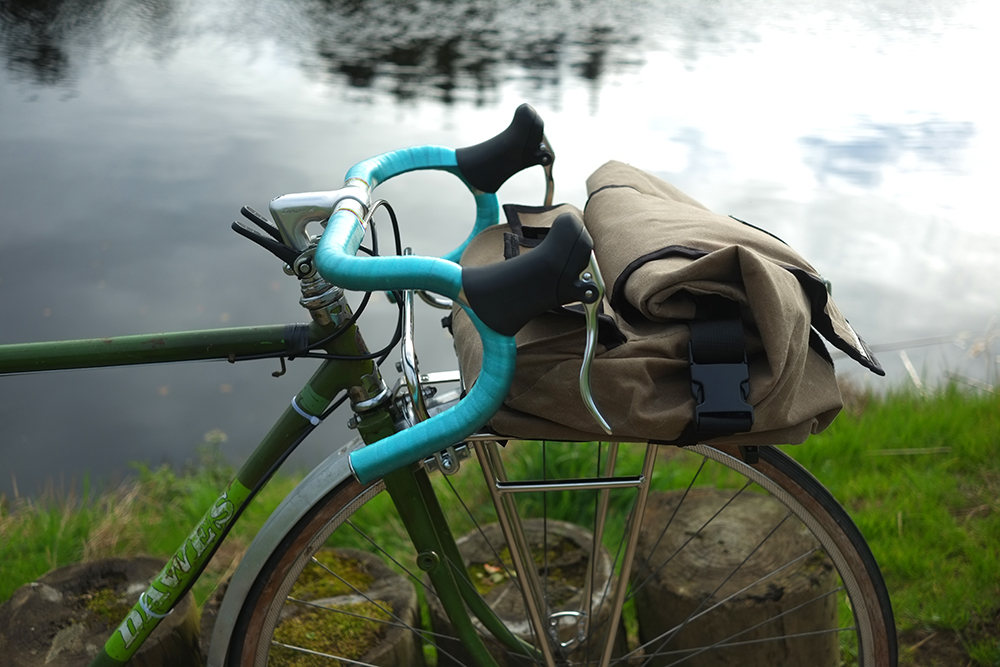
At the start we had planned to build the bike up with just the bare minimum of parts to make it ridable; no racks or fenders or anything extra. However, just as we started the build I rereceived this front rack to test from Pelago bikes in Finland, and this porteur rack bag from Inside Line Equipment's UK distributor. Both were said to work particularly well with a drop handlebar setup. Did I have a bike to fit them on? Hmmm, as a matter of fact!
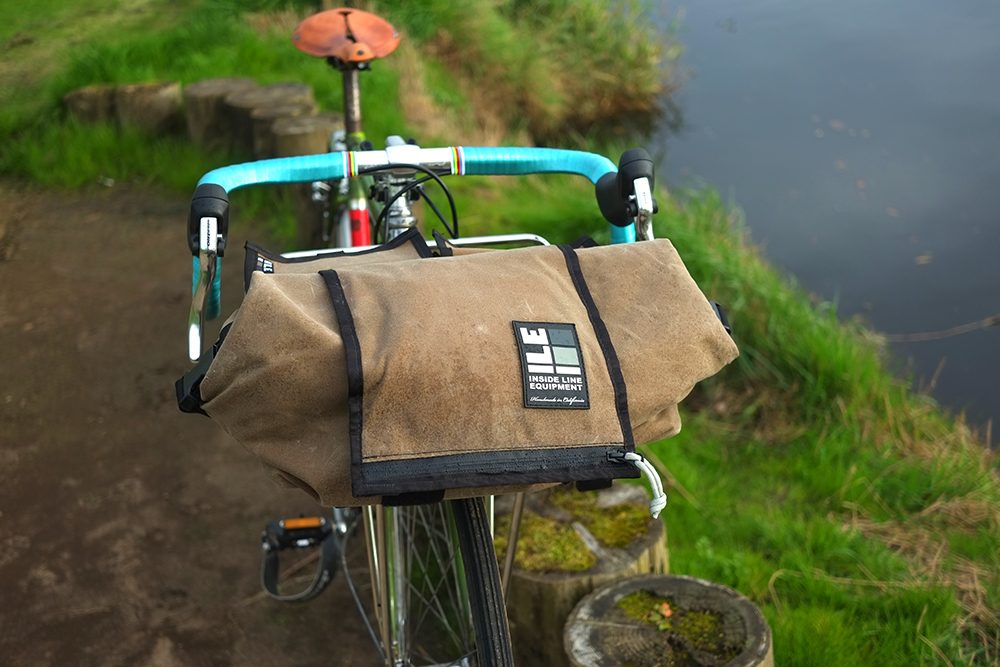
And that is how the Dawes became a transporteur, if you will.
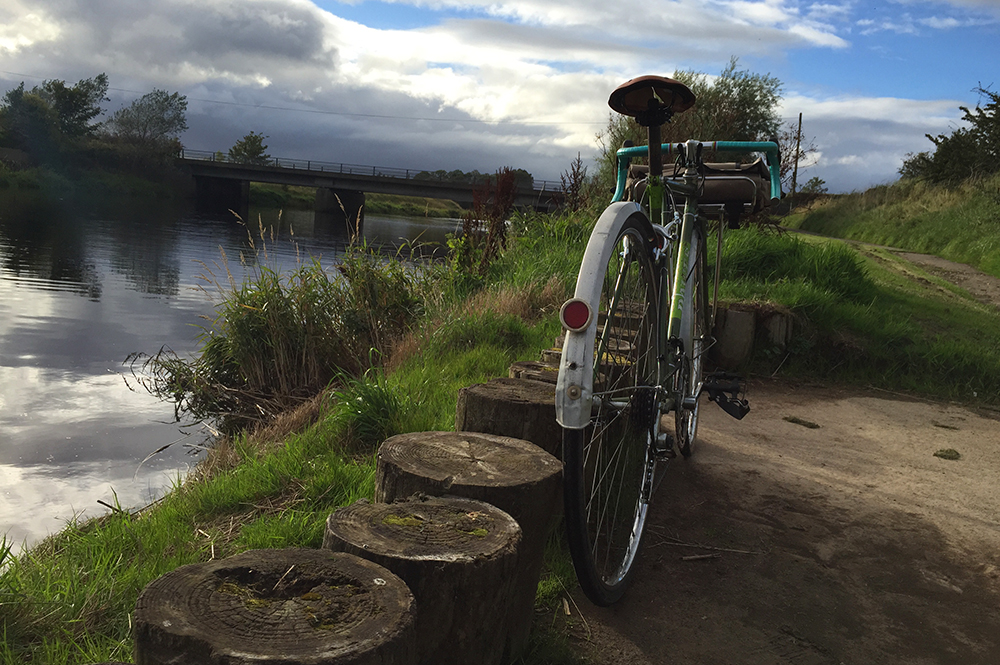
Of course, once it was getting fitted with a rack and bag, it couldn't do without mudguards. Amazingly, we found a couple that looked sufficiently similar to one another to resemble a matched pair.
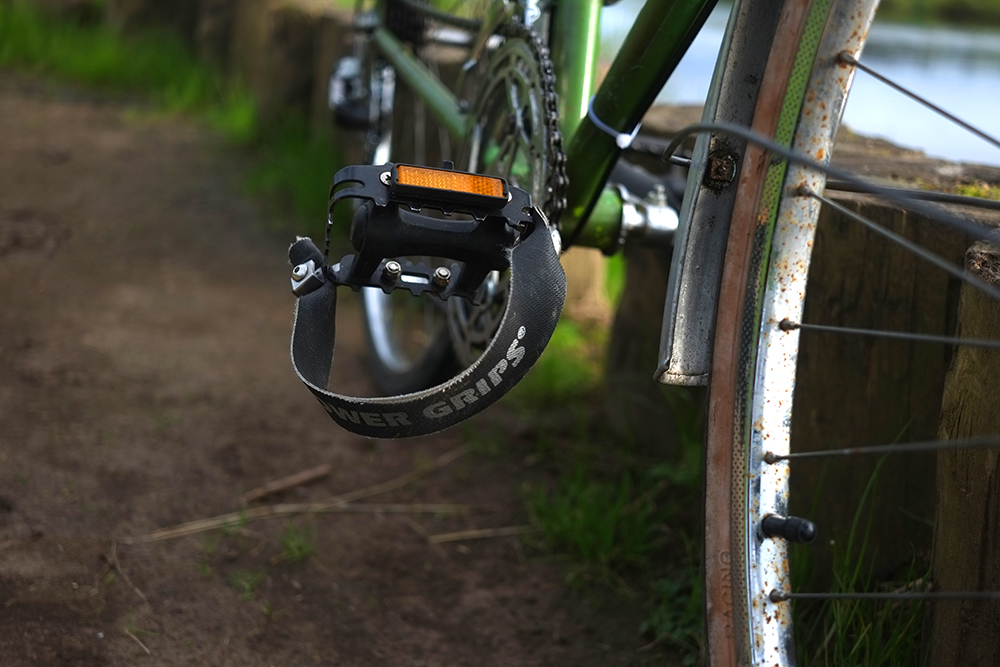
Rejecting my offer of clipless Crankbrothers, Bryan supplied these old MTB pedals with Power Grips - exciting, as I used to love these things but have not ridden with them in a couple of years.
With the build completed at the start of this month, first Bryan rode the Dawes for a week, then I did the same, and will soon hand it over to yet another rider. The ride quality of this bicycle is just excellent. I mean, really: Unless you are after a racing/ performance-oriented roadbike, or something really specific like a low trail 650B type of thing, the vintage roadbikes tend to ride so much nicer than anything of the same category on the market today, and at a fraction of the cost - that I would encourage anyone looking for a reasonably priced "all arounder" to explore this option. It need not be a fancy frame either. As readers have pointed out in the earlier post about this Dawes, it is most likely a low/mid-range Star Celeste model. Nothing special, and yet the ride quality is soft as butter, the speed does not disappoint, and it climbs pretty well even with a decent amount of weight in the front!
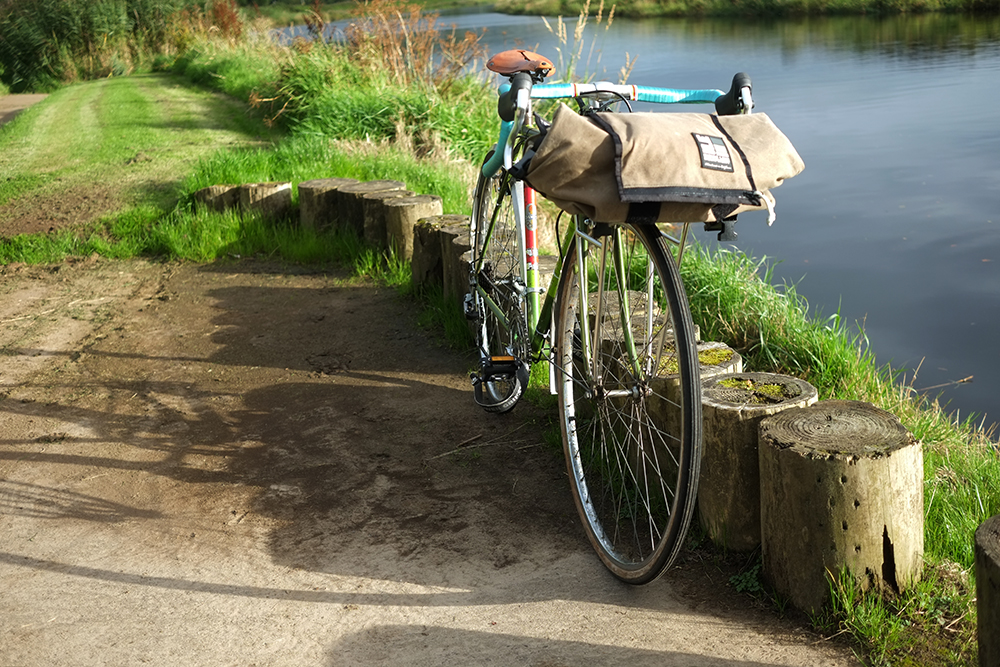
I have not ridden a dropbar roadbike with a wide porteur rack setup before, but it's a combination more riders seem to be embracing lately - offering the benefits of both hauling utility and long distance coverage. As long as the rack and bag are attached well, and the weight sits sufficiently low, I personally do not feel that a low-trail front end is necessary for this setup. This perfectly ordinary mid-trail Dawes, for instance, feels very ridable with a day's worth of stuff in the front. Just make sure that your bicycle's frame and fork are beefy enough to handle the weight you are planning to carry and give it a try. From Velo Orange and Soma, to CETMA, Pelago, and a range of custom options, there is now a slew of wide front racks to choose from for this purpose.
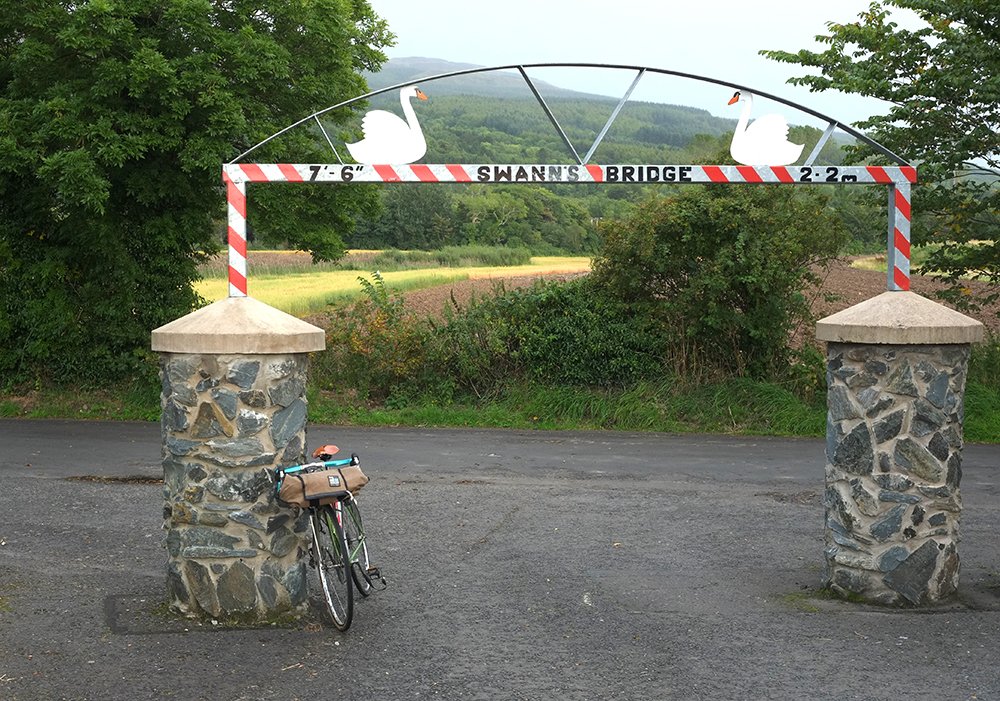
With its 56cm top tube, our little franken-Dawes project is definitely too long for my comfort zone, so it is unlikely I will end up this bicycle's owner. But the setup itself, I think, is a winner. And having ridden the Dawes in this configuration makes me want to turn one of my own roadbikes - most likely the fixed gear Mercian - into a "transporteur." A winter project perhaps.
In the meanwhile, I hope you enjoyed the show and tell of this bicycle. I have certainly enjoyed riding it, and hope its quirky dimensions will eventually find a permanent companion. You can view the full picture set here. And if you're local and would like to try it, drop me a line!

I built up a Dawes Julia that I picked up as a frame and fork, It is all aluminum and I had a lot of really nice stuff to build it with. It can be seen at the Dawes website, it is the blue one with a top tube bag that is being held in my work stand, it is in about three or so pictures. http://dawescycles.com/riders-gallery/you-and-your-dawes/ Your frame would have fit me just fine as I am short lower and long top.
ReplyDeleteAs somebody who tends to accumulate old steel bikes, nearly all of my bikes get some level of this treatment. I really do find it satisfying to take some old thing and give it a new life. "All 'rounders" or "Transporteur" or whatever you want to call them are the perfect treatment for the things. Bikes with "sport touring" geometries tend to be right in the sweet spot for this.
ReplyDeleteI look forward to your thoughts on the front rack. I'm building up a bike that is going to be very similar to what you've got with this Dawes, and am looking at options for the front rack.
BTW: I really like stem shifters, even though they are seen as fixtures on "cheap" bikes. I ride very tall bikes, so DT shifters are uncomfortable for me, and I just don't really care for brifters. I tend to go with bar-ends and stem shifters on everything. When I have a mostly upright bike, stem shifters really are positioned just right for me. Oh, the heckling I get on rides with friends...
That bag seems as if it could use a bit more structure. Seems like it would shift all over the place on a ride.
Wolf.
Wolf
Deleteagreed, looks floppy in these photos, but the bag has structure in the bottom and the back, and when paired with a slightly deeper rack, like the VO or Soma, it fits and looks great.
Eric
ILEquipment.com
I've built many of these, as I suspect more than a few of your readers have, and they're always (mostly) fun projects. Putting an old school bike together from scratch is rewarding and a reminder of how simple these machines were. The tricky part comes in with actually using them after the romance period. Maybe you're the Jay Leno type and enjoy simply having a garage full of bikes to take out on occasion and enjoy reminiscing about their history but if one is going to use it, many things become problematic -- at least in my experience. A lot of adjusting and fiddling and if one is into that, cool, but if not, a modern bike may be the answer. I agree that long top tubes are especially problematic. On of my bikes had this issue and despite my desperate desire to keep the drop bars on it I had to admit it was never going to be comfortable until I found a shorter solution. I found some flatish aluminum bars which brought the reach back yet kept an aggressive position and modified some bar end shifters to come out the bar ends and all of a sudden it became my favorite all around bike for getting stuff done. Mostly, if it doesn't work, change it, don't be precious about it and you may be surprised with something you could not have found hand you not gone through so many adjustments and iterations.
ReplyDeleteAlso, that shifter cable routing looks kinda funky….what's up with that?
I'm not sure how to describe my attitude toward vintage bikes exactly - other than that I like them, can't keep away from them, and seem to derive a joy out of riding them, regardless of pedigree or "historical value," that I do not get from modern ones. In a way I've had the opposite trajectory to what you describe, in the sense that in earlier years I thought vintage bikes were too unreliable to be "main bikes" because they're old and required fiddling with/ were prone to breaking down, etc. - but have since grown to trust them more, as in practice few have ever let me down or left me stranded. For a lot of people, I think an optimal solution would be a vintage + modern melange, whereby parts such as tyres and brakes would be purchased new, but the rest of the bike would be left as-is.
DeleteShifter cabe routing… Not my handiwork. But seems fine to me.
I don't think they're so much prone to breaking down as much as it takes a bit of care to keep the bearing surfaces adjusted and clean and fiddling with the fit for a truly good ride. Generally, they're stout and would never leave you stranded as long as the wheels can roll. I've notice you've gone through a lot of old bikes and then moved on, mostly they've seemed from the high quality end of the spectrum. And, I certainly agree that old bikes can be made perfectly ridable and usable with minor modifications. A decent set of wheels would be my first consideration and then some decent brakes and then, maybe a better rear derailleur and then, damn, i think i can find a lighter crank, wouldn't that be cool?…and on and on it goes…it's a personal thing, right?
DeleteThe cable routing for the rear derailleur is unusual but the outer was too short to reach the using the usual route underneath the BB shell and there were no downtube shifter boss to use to have exposed cables so I found a shorter route for the cable!
DeleteThe barrel adjuster is missing from the rear mech but it's not really needed when you're not using indexed gearing.
BW
Be careful re wheels: Increasingly, I get the impression that the old "crappy" wheels are a crucial part of that magical vintage ride quality.
DeleteI've gone through a lot of vintage bikes largely because I'm a blogger / industry person. I experiment, share the results, then move on because I can't afford to keep them all. The (unplanned) Boston-Ireland move was a contributing factor as well. As far as high vs low ends of the spectrum, Im actually at the low to mid range when it comes to my vintage bike ownning history. Motobecane Mirage, Raleigh DL-1 - those re not exactly historical gems. But I am open to any and all, as long as they are rideable and not wall-hangings decor.
With regard to the 'crappy' wheels….Well, I don't need your advice on that one. The magical vintage ride quality thing is meaningless or empty to me and if it's magical to you then we've just different tastes on what works or adds to one's experience. Since I started riding road style bikes in the late 60's old steel rims are all I've known and there's never been anything magical about them so there's no nostalgia on my part. I mostly build my own wheels and finding strong aluminum rims and decent hubs have many many old bikes more enjoyable and a bit safer.
DeleteYes, you seem to embrace the entire spectrum of old bikes, I just remember the Trek, Moser, Bianchi type of bikes which briefly circulated in your stable. I think it was Bruce Gordon who suggested the best thing for a transportation bike is finding a old steel frame and setting it up with the kinds of components to make it work for you. Old steel frames have many lives available and can be adapted quite easily for safe and fun riding. Thanks.
Touché. And long live Bruce Gordon.
DeleteOne smooth, fairly fast, comfortable old bike I've ridden is the 12 speed double-butted 80s Schwinn LeTour mixte. It needed some repair, including a bend derailleur hanger and new wheels. I usually give an old bike an overhaul - cables, brake pads, tires and tubes. They just run better. The tires weren't in good shape [for 27 1/2" x 1 1/8" tires]. I purchased a new set of 27 1/2" aluminum wheels that would allow 1 1/4" wide Panaracer Pasela TG gumwalls. Wow did that make the ride comfortable. Since the frame was a bit large for me I used VO Milan upright handlebars I had on hand. The ride turned out to be comfortable and the bike wanted to go. I wish at times I still had this bike. It made me feel good that it was rolling after being stored in a dusty old shed for many years.
DeleteOf course it's the wheels.
DeleteThe magical butter ride is a function of flat, flexible rims and low spoke tension. The spokes and the rim move around rather a lot as they churn butter. Modern wheels cannot do this. To accommodate an eleven cog cassette they have almost no dish and need extremely high spoke tension. And rims strong enough to withstand that tension. Dual-pivot calipers won't work but with very true wheels and to make that happen rims are tall, inflexible, very stout. And they become cartwheels. They sure ride like cartwheels. The only upside is they require no maintenance. Since very few but yours truly ever did wheel maintenance maybe modern makes some mass-market sense. But if you want the butter ride there's no way to have it but vintage wheels. They are always a bit wonky and you need to own a spoke wrench and use it. It's worth the effort.
There is some charm in as-found wheels. I hope you are at least going to the trouble of making them straight. Next you start to have some discrimination about which find is worth carrying home and then you start to build your own. It's the difference between home cooking and the microwave. I like my butter spread thick. Current top wheelset has rims that measure at 360 grams and all of 11.6mm tall. That recipe sure will flex. My sweetie is on 280 gram rims that are aluminum/wood composite and stand all of 10mm tall. Ever try farm fresh butter in Iceland? Her rims are strong enough to fly with only 24 spokes and I expect them to last at least 20,000 miles. They would collapse on the wheel stand if you tried to build them to modern hubs.
That cable routing is nothing unusual. Done often by design, done often by default. Go back far enough and steel rims were not a marker of cheap junk, they were just another choice. There have been many high quality steel rims.
If you want to respace the rear forks on the Seven to 120mm and build some good wheels, the brifters might or might not work with a 5 or 6 speed freewheel. Older Campy brifters will definitely do the job. You would also need vintage brake calipers.
Slowly and definitely I got rid of the rear rack on my favorite low trail 650b.
ReplyDeleteMy VO front rack is convenient but when I stop, if I don’t catch my handlebar, it falls at right or at left.
It’s an effect from both heavy bag and high front rack.
This trouble can be solved by a spring between frame and fork: so I bet it’s the same issue with this 700c transporteur.
L.
How much weight can you comfortable carry over the front wheel (and with a stout, firmly attached rack)? I've been experimenting with front loads on my (I assume) mid trail Rivendell, but on newly made lowrider racks. 10 lb/side seems to be as much as it likes, at least without a balancing rear load, where it happily carries 30 lb.
DeleteOld bikes: strangely, my best rear-load-carrying frame was a light, tout 531 1973 Motobecane Grand Record, which carried 40lb+ on a rear Fly, and did so better than any of the other, and often stouter tubed, bikes I've owned.
Yeah. The (27"!) transporteur wheel-flops epically when not in motion. Doesn't bother me enough to get one of those srpingy things though (which, in my experience, don't work anyhow!)
Delete10 Lb (5 kg) seems to be by my usual standard front load (I will check it) without food, this pack is usual for me to a day ride in summer, early autumn or end of spring. Here a picture of contents: “http://www.kirikoo.net/images/7lemage-3-20150620-142143.jpg”
DeleteThere is a small touch of survival stuff for alone ride.
In fact, as a Bicycle Quarterly reader I tend to have more or less a similar bike to Jean Heine’s: no rear rack, no spring, no stand …
L.
Humm, I've checked the weight of my full front bag: it's around 7lb (3kg)...
DeleteL.
Great idea I think to turn your Mercian into a front load drop bar commuter. Would you keep it as fixed gear or convert to 3-speed Sturmey Archer? (You can do coaster brake if there are no rear brake provisions, right?)
ReplyDeleteIt's fitted with a rear brake, so that's not a problem. I wish I liked the SA S3X hub better, because in theory that would be ideal. But I just can't warm to it. For now I would keep it single speed fixed gear, everything as-is and just attach a front rack and mudguards basically. Should be good!
DeleteAnother fixed/multi gear hub to consider is to modified a cable operated Bendix two speed. The coaster brake parts are removed and the planet gear ring is welded to the hub. Incredibly simple (I can tear it down and rebuild it within an hour) and works great. I've been riding this set up on my Quickbeam since the spring and couldn't be happier with it. All the pleasures of a fixed gear with a low gear option for the really tough hills.
DeleteIf one were to have a simple single speed bike, like yours, why a front rack and not a rear?
DeleteIs that bag still usable (i.e. narrow enough) when filled to capacity? Please share your experience.
ReplyDeleteThis will depend on your headtube height and the width of your handlebars, as well as on how comfortable you are with "knuckle rub." My hbars are 42cm and my HT is virtually non-existant, yet can still use this bag filled to capacity because the rub does not really bother me. Please hang on for the review for further details.
DeleteI also am a pushover for any old steel bike, but my enthusiasm stops at the steel wheels. They no longer feel safe to me in terms of stopping, which due to my heft is admittedly a chore. But if the build stays together, steel wool's the charm!
ReplyDeleteThe first photo, the handlebars look off/awkward/uncomfortable. I can't imagine that three different people could ride this as it's set up and not have issues. Flatter bars on that stem and the imagined angles of a rider seem much more plausible and comfortable. I don't know what they were thinking back in those times but we've come a long way in understand fit since then.
ReplyDeleteThe handlebars are actually modern Nitto Noodles, not vintage bars. As drop bars go, I'd say they tend to be a crowd-pleaser. Lots of hand positions and roomy flat areas for keeping your hands on or near the hoods. Today you'd normally see thicker tape on the bars, giving the appearance of the hoods being more smoothly integrated with the ramps. But as this tape is the thickness of gift wrapping ribbon, so you don't get that effect.
DeleteI recognized the bars as your old Nitto's but was referring to the fact that it's such a long reach to the hoods. Most riders prefer the hoods, and with this long top tube and those bars it seems an extra long reach -- at least visually. I don't know what they were thinking with those long top tubes ;)
DeleteThe Nitto B-177 (or “Noodle bars”) are among the most uncomfortable road handlebars I’ve ever used. One of the problems I had with them is apparent in the picture Anonymous 8:10 PM refers to: if you tilt the bars so the ramps (and drops) provide a comfortable hand position, the top section slopes downwards. For me, this more or less rendered this position useless, as it put my wrists in an odd, twisted position. In addition to that, it looked awkward.
DeleteAt 95mm, reach may seem long in comparison to modern “compact” handlebars, but isn’t all that long when compared to vintage designs or their modern remakes. The curved top section reduces reach by about 15mm. The ramps aren’t even long enough to provide a full hand position when the handlebars are set up with the drops horizontal to the ground.
I suppose Grant Petersen expects riders using this bar to set it up well above saddle height, so they can use the hooks and drops most of the time – which are the only positions I can imagine might work well.
Frankenbike is a relatively new term to me. It's interesting when things are labeled, defined, reduced, for purposes of a discussion. Is this label new? Certainly, modifying bikes is not new. Constructing something from parts remains remains a joy for many of us…the question is, as always, does it work?
ReplyDeleteI suspect the word originated on bikeforums, about a decade ago. In most contexts it is meant to be humorous/affectionate.
DeleteI was a modern road bike advocate, living, breathing all things light weight and fast. Until I was drawn to and inexpliacbly purchased an old 1972 Raleigh Super Course off of CL. Someone had changed the original handlebars to a stingray style which I quickly removed and installed an old set of drop bars that I had. I took it out for a trial ride thinking that it would be more like the old Schwinn Varsity that I had ridden as an adolescent. I couldn't believe the ride quality. I was smitten, as it were. I may not have been as fast but the ride was so smooth and intuitive that I was hooked. I rode my modern "fast" bike a couple of times after that but my heart had changed. I realized that I loved the ride much more again. The joy is not in how fast I can finish the course but in the journey itself.
ReplyDeleteI like this bike - I love how individual it is - there is something about old bikes which have been 'revamped' that is just so appealing.
ReplyDeleteIt seems as though steel rims have a strong flywheel effect and I wonder if that may be the overriding factor in the "feel" of the ride. That could result in the bike carrying momentum farther and maybe even make if feel more stable at speed.
ReplyDeleteBefore your blog I'd never, ever, seen nor heard of Power Grips. And now a guy in northern Ireland also has them? You're a match made in heaven! Either that or I'm skeptical. Do you allow skeptical posters? Building up bikes from scraps is always fun. It's called collage. Question is, as always, does it work?
ReplyDeleteBest thing about this bike is the Patina and the colors! Little bit of a Sam throwback isn't it?
ReplyDeleteBy the by, how are you? Hope everything's fine as you have been unusually quiet!!!
-masmojo